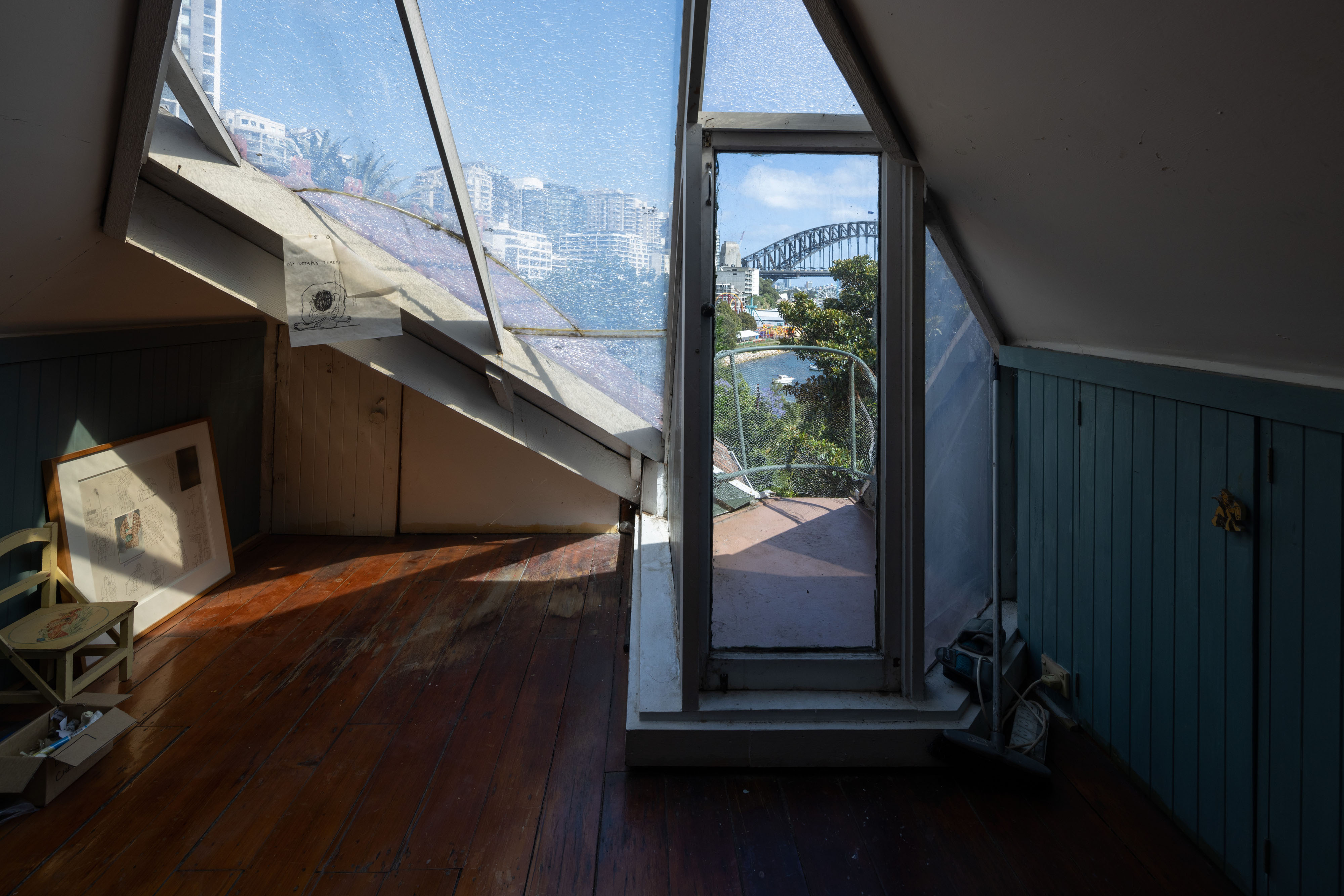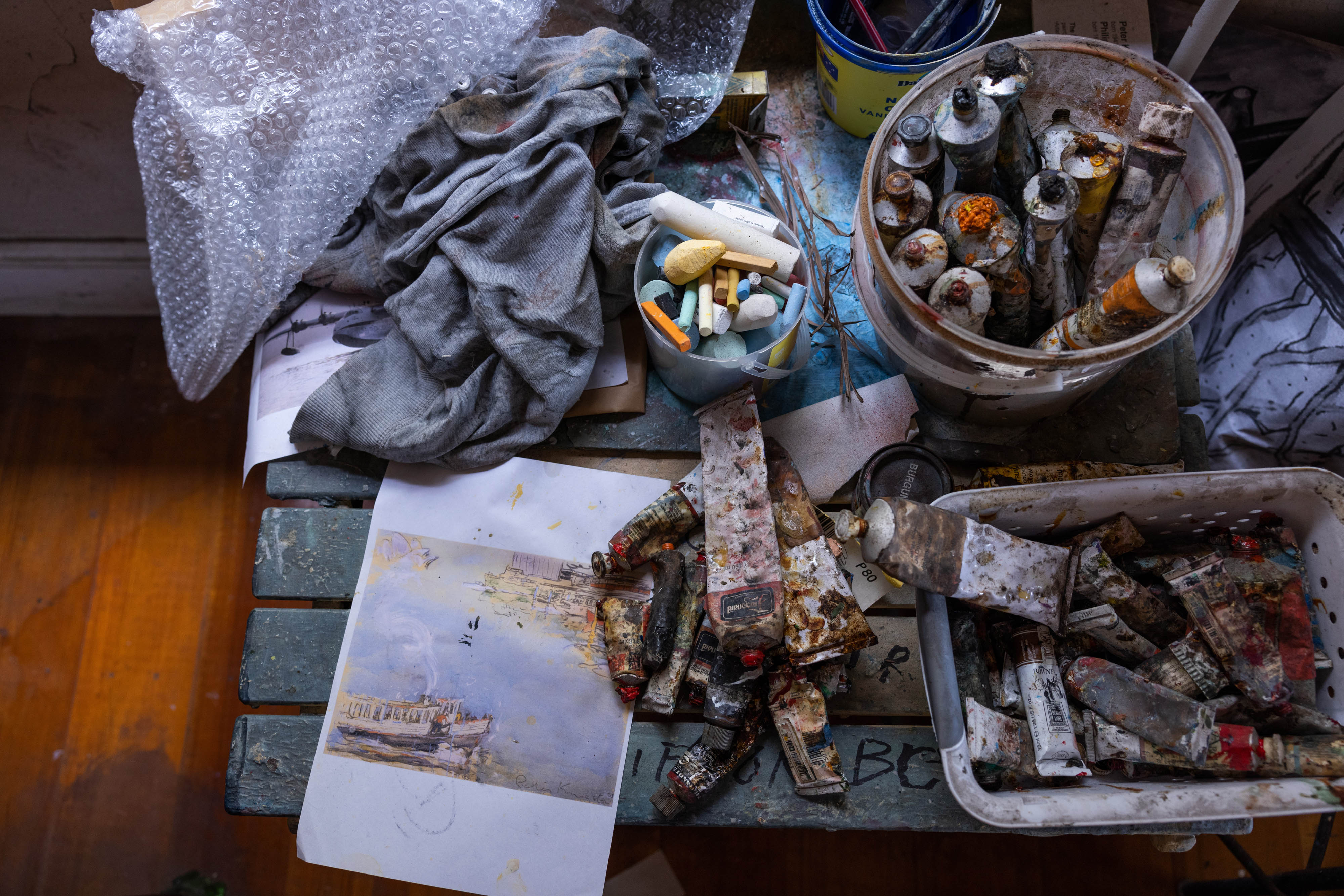Ferry scene linocut print from Kingston’s artists’ book 'Sydney Deckie', 2004
n/a
By Elizabeth Fortescue
The feeling of entering a magical realm begins before you even get to Peter Kingston’s former home in Lavender Bay. You leave the street on the hillside above the house and take the steeply sloping stairs towards the harbour. Not wanting to miss your footing, you try to ignore the cobalt seductiveness of Sydney Harbour glinting through a frame of trees way below.
Ginger Meggs zooming downhill in a billycart — or at least, a small wooden figurine of the old-time cartoon character — comes into view on the fence line outside Kingston’s place. You open the gate, cross a kind of rickety gangplank above a tangled garden, and enter the artist’s romantically tumbledown home. It resembles, as his sister Fairlie Kingston puts it, ‘a studio that someone happens to sleep in’.

View towards Sydney Harbour Bridge from Peter Kingston’s bedroom.
Kingston lived here for almost 50 years in a state of unwavering creative immersion. He bought the atmospheric old house in 1974 with inheritances from his father and from an elderly family friend and neighbour called Olly Eyles. (He speaks fondly about Mrs Eyles in an oral history interview with Margaret Leask, available on the Library’s website.)
Kingston died in his house on 29 September 2022, aged 79, after a cancer diagnosis in November 2019. Kingston’s art encompassed everything from ephemeral pavement drawings to oil paintings so large they had to be taken out over the balcony for his posthumous exhibition at Australian Galleries last December.
Lavender Bay without Kingston feels like a vacuum, as his long-time friend and neighbour Jan Allen puts it. Signs of his absence are painfully abundant. The MV Anytime, Kingston’s little wooden boat, that he used as a floating studio, bobs idly in the bay. Luna Park, so close to his heart although shot through with pain because of the tragic Ghost Train fire in 1979, can be seen along the shore.
Statuettes of May Gibbs’s Mrs Kookaburra and Dorothy Wall’s Blinky Bill peek out from native bushes on the officially named Peter Kingston Walkway that runs along the shore below the Ferries criss-cross the bay in a flurry of churning froth.
‘These little ferries — every time I see them come in I think, “Oh, I haven’t got it quite right yet,” ’ the artist told the author in 2001, before his beloved ferries stopped running.
Now that Kingston is gone, the future of his former home isn’t clear. Fairlie says it will probably be sold. But whatever happens, there is one sense in which the house will always remain as it was when a great artist lived and worked here. Shortly after Kingston’s death, Fairlie agreed to the Library’s proposal to photographically document the house as a site of lasting historic and artistic significance.
Future generations might not be able to visit ‘Kingo’s’ house, but they will be able to see virtually every inch of it, inside and out, thanks to the almost forensic rigour with which Library photographers Joy Lai and Russell Perkins recorded it.
Using Heritage Office guidelines, Lai and Perkins photographed the house and its contents in obsessive detail. This project took place just days before the art removalists were due to take away Kingston’s final pictures for the 6 December 2022 exhibition at Australian Galleries in Paddington. Openbook editor Phillipa McGuinness walked around the house recording Fairlie’s voice as she explained the provenance of many works and told stories about various items being photographed, creating an invaluable archival record that will sit alongside the photographic rendering of the house.
In due course, the photographs of Kingston’s home and studio will appear on the State Library’s website, providing a unique and lasting resource long after the house becomes someone else’s home.
The Australian Galleries’ exhibition was titled ‘Peter Kingston 08.05.43 – 29.09.22’ and was as close as Kingston came to a memorial, the artist having left Fairlie with strict instructions that his passing not be marked by speeches or fanfare of any kind, let alone a funeral.
Fairlie Kingston in her brother’s studio. Photo by Joy Lai
Fairlie Kingston is also an artist. Tall and athletic-looking with a tumble of curly hair, she is 11 years Kingston’s junior and was his soulmate ever since their idyllic childhood in harbourside Parsley Bay with their older sister, Caroline. Their father, Percy Kingston, had a decades-long career as the Sydney agent for 20th Century Fox, sparking his son’s lifelong fascination with film and vintage movie theatres. Their mother, Betty, was, in Fairlie’s words, ‘odd, imaginative and humorous’.
After leaving home, and living in an old stables with Jan Allen and others in Surry Hills, Kingston bought the Lavender Bay house next door to his friends Brett and Wendy Whiteley. The stability of home ownership and the freedom from rent payments allowed Kingston to become an artist, Fairlie says.
Kingston gained a degree in architecture but never practised. Although he never studied art formally, his natural abilities were amplified by his association with a wide circle of artist friends such as Brett Whiteley, Garry Shead and Martin Sharp. Kingston inherited his father’s drawing facility, and in the 1980s he became known for his pictures of Sydney Harbour and, particularly, Luna Park.
Anne Ryan, Curator of Australian Art at the Art Gallery of New South Wales, was among the throng at the opening of the exhibition at Australian Galleries in December. ‘Peter’s paintings are lovely and they are quintessentially Sydney,’ Ryan told me. ‘But for me, his drawings have that authenticity and rawness.’ Kingston himself used to say that drawing was at the heart of everything he did.
One of Kingston’s endearing characteristics was a guileless enthusiasm for his various heritage and environmental causes, mixed with varying levels of confidence about his artwork. ‘He was never sure. He was always questioning his decisions,’ Ryan said. But Kingston was always so certain of the rightness of his causes that he attacked them constantly and fearlessly. A case in point was his campaign to help save the dugongs of Hinchinbrook Island when the peaceful sea creatures were under threat from over-development of their habitat on the Queensland coast. To bring the animals’ plight to the attention of politicians, Kingston made a papier-m.ch. dugong on pram wheels and pushed it into the path of then Prime Minister John Howard and his entourage during one of their morning power walks around Lavender Bay.
‘It could have had a bomb in it, you know? And he’d be lying there in wait,’ Fairlie said. ‘Or he’d have drawn something on the concrete and the minders would pour water over it as they walked past. I’m sure ASIO has a dossier on him.’
Other notable Kingston-backed causes included the preservation of Luna Park, the Walsh Bay Wharves, May Gibbs’s Neutral Bay home, Nutcote, and the Lady-class ferries. He made artworks about them all, from artists’ books (many of which are held in the Library’s collection) to linocut prints, drawings, paintings, custom chess sets, lampshades and assemblages.
Kingston said in 2001: ‘As an artist, I’m attracted to things that are eccentric and bent and curved, and they’re usually things that are old. So one’s attracted to draw these sort of things, and not long after they’re always pulled down.’
With his deep passion for preserving the best of Sydney’s history, it’s not surprising that Kingston was an inveterate email writer, spending huge amounts of time bombarding government ministers and other powerful figures. Kingston believed that Australian governments cared little for history.
Indefatigable, Kingston brought endless energy to his art production and was even working in the studio on the day of his death. On that day, a few close friends had gathered at the Lavender Bay house, sitting on the old cinema seats that were an essential part of what he called King’s Theatre to watch the film Out of Africa, one of his favourites. As usual, he projected the film on a pull-down screen in the living room. ‘After about a third of the film, he said “Oh, I’m not feeling great, I might have a bit of a lie down,” ’ Fairlie said. ‘And so by the time the film ended I went in to see if he wanted some lunch, and he’d died.’

Note the figure of cartoon character Boofhead, in profile.
Note the figure of cartoon character Boofhead, in profile.

The colour he perhaps used most often was called ‘Kelp’.
The colour he perhaps used most often was called ‘Kelp’.

Note the figure of cartoon character Boofhead, in profile.
Note the figure of cartoon character Boofhead, in profile.
They had discussed death frankly, and Kingston had faced his illness without bitterness. He was enormously grateful to Fairlie, who lives in Watsons Bay, for spending so much time living with him in Lavender Bay in his final months. ‘Every day I’d make his bed and he’d behold it as though it was a work of art. He was just an absolute treasure,’ Fairlie said.
Fairlie’s recipes for smoothies and porridge are still stuck on the fridge in Lavender Bay. They were her sisterly reminder to Kingston to take some time out from his projects and causes to look after himself.
Kingston’s death brought their long mateship full circle. ‘I remember he did a wonderful thing for me when I was about six,’ Fairlie said. ‘For my birthday he made me a little puppet theatre and it was absolutely wonderful. It had a winding staircase and all the scenery and backdrops.’ Fairlie believes the puppet theatre ignited her imagination. Among her ceramic artworks are little illuminated lighthouses and seaside cottages like the ones near their Parsley Bay childhood home.
Stuart Purves, who represents both siblings at his Australian Galleries, is planning more exhibitions of Peter Kingston’s work. ‘He had so many things on the go at the same time,’ Purves said. ‘It’s a matter of Fairlie, who’s very much in charge of his legacy, categorising the things that are left and making a series [of exhibitions] going on for many years.’
No more artworks will be made in the magical old house in Lavender Bay. But the house will live forever, just as Kingston left it, through the State Library photographers’ lenses.
Elizabeth Fortescue is a freelance journalist and regular Openbook contributor.
This story appears in Openbook autumn 2023.
Openbook is for people who love to read.
As she finalises work for her landmark exhibition at the National Gallery of Australia, Sydney artist Cressida Campbell invites Openbook into her studio.
Peter Kingston couldn’t please everyone in his artist’s book Sheilas, but the result is a special piece of work.
A selection of visual diaries of Australian artist George Gittoes, covering the period between 2001 and 2014, have been recently digitised by the Library.